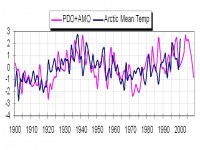By Roger Pielke Sr. Climate Science
An excellent new paper is “in press” for Geophysical Research Letters (GRL) which documents the major role of regional atmospheric/ocean circulation pattern changes on regional multi-decadal climate variability (e.g. see What is the Importance to Climate of Heterogeneous Spatial Trends in Tropospheric Temperatures?).
This paper supports the finding that long term variations in atmospheric/ocean circulations (such as the Atlantic Multidecadal Oscillation, the Pacific Decadal Oscillation, ENSO, etc) cause regional changes in temperatures over this time period, and that these changes have a significant natural cause. Such a perspective supports the views of Joe D’Aleo (see) and Bill Gray (see) and Roy Spencer (e.g. see).
The paper is: Chylek Petr, Chris K. Folland, Glen Lesins, Manvendra K. Dubeys, and Muyin Wang: 2009: “Arctic air temperature change amplification and the Atlantic Multidecadal Oscillation”. Geophysical Research Letters (in press).
The abstract reads
“Understanding Arctic temperature variability is essential for assessing possible future melting of the Greenland ice sheet, Arctic sea ice and Arctic permafrost. Temperature trend reversals in 1940 and 1970 separate two Arctic warming periods (1910-1940 and 1970-2008) by a significant 1940-1970 cooling period. Analyzing temperature records of the Arctic meteorological stations we find that (a) the Arctic amplification (ratio of the Arctic to global temperature trends) is not a constant but varies in time on a multi-decadal time scale, (b) the Arctic warming from 1910-1940 proceeded at a significantly faster rate than the current 1970-2008 warming, and (c) the Arctic temperature changes are highly correlated with the Atlantic Multi-decadal Oscillation (AMO) suggesting the Atlantic Ocean thermohaline circulation is linked to the Arctic temperature variability on a multi decadal time scale.”
Text in this paper includes: “In the following analysis we confirm that the Arctic has indeed warmed during the 1970-2008 period by a factor of two to three faster than the global mean in agreement with model predictions but the reasons may not be entirely anthropogenic. We find that the ratio of the Arctic to global temperature change was much larger during the years 1910-1970.” “We consequently propose that the AMO is a major factor affecting inter-decadal variations of Arctic temperature and explaining [the] high value of the Arctic to global temperature trend ratio during the cooling period of 1940-1970.”
“Our analysis suggests that the ratio of the Arctic to global temperature change varies on [a] multi-decadal time scale. The commonly held assumption of a factor of 2-3 for the Arctic amplification has been valid only for the current warming period 1970-2008. The Arctic region did warm considerably faster during the 1910-1940 warming compared to the current 1970-2008 warming rate. During the cooling from 1940-1970 the Arctic amplification was extremely high, between 9 and 13. The Atlantic Ocean thermohaline circulation multi-decadal variability is suggested as a major cause of Arctic temperature variation. Further analyses of long coupled model runs will be critical to resolve the influence of the ocean thermohaline circulation and other natural climate variations on Arctic climate and to determine whether natural climate variability will make the Arctic more or less vulnerable to anthropogenic global warming.” See Roger’s full post here.
Icecap Note: What we found:

Larger image here.




